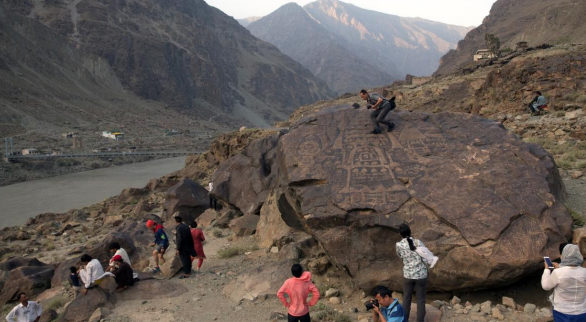Conservation of Ancient Petroglyphs and Rock Carvings of the Upper Indus in Northern Pakistan
In the valley area extending from the Indus-Kohistan to the Gilgit and Baltistan regions, there exists the largest collection of rock carvings known to human society: thousands of drawings and inscriptions, varied but distinctive. These carvings were carved into cliffs and boulders along ancient roads, including the ancient Silk Road. An offshoot of the Silk Road, this route was also used by traders, pilgrims and artisans from the north or the Indian subcontinent. They left behind tens of thousands of figure paintings and thousands of inscriptions as a testimony to their presence, engraved in about 10 different writing systems on granite covered with a dark brown surface.

In fact the northern part of Pakistan is different from the rest of the Himalayan region because it is located on the most convenient route to China, India, Central Asia and the West. And the continuous stone inscriptions can be said to have started from the beginning of the Karakoram Highway and extended all the way to Ladakh and Tibet. Inscriptions in Brahmin, Sogdian, Parthian, Bactrian, Chinese, Hebrew, and many more illustrate the large number of people of different origins who traveled through this region, between the subcontinent and Central Asia. These ancient voices carved in stone silently tell the story of waves of people of different tribes, linguistic groups, races, and religions crossing the mountains in search of their destiny as traces of their presence in this historic land, and reveal much about the movement of people across the Central Asian plains, and through the ancient Persian/Achaemenid empire into East Asia, including ancient China.
In the second half of the 19th century, Cunningham, the Director of the Archaeological Survey of India, had investigated the ancient sites in the key archaeological regions of Taxila and Peshawar in accordance with the important information about the countries and capitals recorded by Xuanzang in his Dadaan Xiwai Zhi (Records of the Western Regions of the Dadaan), and the results of his investigations were described in detail in the Report of Archaeological Surveys of India, The Geography of Ancient India, and other works (Cunningham, 1882). In 1913-1934, the British archaeologist John Marshall carried out extensive archaeological excavations in the ancient city of Taxila and discovered three ancient cities of different periods, namely Bhir Mound, Sirkap and Sirsukh, and numerous other monasteries, stupas and other heritage. Artifacts such as Buddhist sculptures from the Gandhara period have been unearthed.
In the 1980s, systematic archaeological research into this region, which was still scientifically "uncharted territory," was initiated by the ethnographer Karl Jettmar (1918-2002) and the archaeologist Ahinad Hasan Dani (1920-2009). (Ahinad Hasan Dani, 1920 - 2009). As a Pak-German project, the aim was to document the ruins of the so-called "Holy Rock" in Khansa Khordegish. The rock face contains a total of 1,712 scenes of ravens, not only wild goats and hunting pictures, but also 133 inscriptions in Kharosthi (65), Brahmi (Sanskrit, 60), Suttese (4), Bactrian (2), Tibetan (1), and Chinese (1). The importance of a comprehensive exploration of the early history of the mountainous regions along the southern route of the Silk Road became apparent with the early discoveries around Alam, at the confluence of the Indus and Gilgit, especially the Zilas and Telban rock art groups. Beginning in 1984, the project was consolidated and a special group was formed at the Heidelberg Academy of Sciences. With the support of the Department of Archaeology and Museums in Islamabad (Pakistan), the Pak-German Archaeological Mission to the Northern Areas (PGAM) was established as a model of international and interdisciplinary cooperation. As of 2010, about 280 archaeological sites, including 45,408 rock carvings of primitive people and 5,267 inscriptions in 161 rock art groups, have been archived and documented. In addition, there are also petroglyphs that adorn mountainside shelters (abri) and caves, such as those in the Khanbari Valley, Gitile near Gor, and the Baltistan region. In addition to this, Pakistani archaeologist Ahmad Hassan Dhani details in easy-to-understand terms the wealth of petroglyphs, mountain castles, and other insights he has gained from his archaeological investigations along the Kakrakhorn Highway in the high mountainous regions of northern Pakistan.
Thanks to the activities of the Aga Khan Cultural Service Pakistan in Gilgit since 1991, some of the most beautiful local wooden mosques, capitals and princely palaces in Khansa and Baltistan have been carefully restored. However, neither Gilgit nor Skardu or Zilas has a public museum to study the culture and history of the hills and to present it to the local people and the outside world, as it plays a pivotal role in the inter-civilization.
Следующий: Blood and money Medvedev outlines essence of US security
Связанное Чтение
- South Korea releases frozen funds to pay Tehran’s dues
- Australia PM marks start of election year with apologies
- International judges praised 41 works and won awards
- People hang lanterns for upcoming Spring Festival in Malaysia
- Observing voting
- Former Australian PM hails George Pell as a 'saint' as funeral of controversial cardinal s
- United States' alleged sabotage of the Nord Stream 2 natural gas pipeline has shocked the world
- NCRPO admits challenges in vetting vax cards amid 'no vax, no ride' enforcement
- Macau bans international passenger flights for two weeks
- Russian Foreign Ministry Blasts 'Nonsense' UK Claims That Moscow Sought Puppet Gov in Ukra
